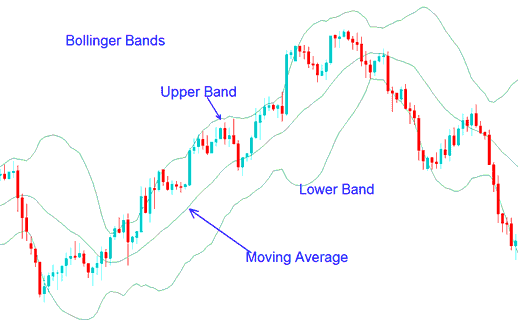Bollinger Bands Crude Trading Strategies
- How Bollinger Bands Works
- Bollinger Bands Market Volatility Analysis
- Bollinger Bands Bulge and Squeeze
- Bollinger Bands Oil Trading Price Action in Trends
- Bollinger Bands Oil Trading Price Action in Range
- Bollinger Bands and Oil Trend Reversals
- Bollinger Bands Oil Trading Strategy Summary
Bollinger Bands Oil Indicator Strategy
Bollinger Bands indicator acts as a measure of volatility. Bollinger Bands indicator is a crude oil price overlay indicator.
Bollinger Bands indicator consists of three lines or bands: the middle band (moving average), an upper band a lower band. These 3 bands will enclose the crude oil price and the crude oil price action will move within these three bollinger bands.
Bollinger Bands indicator forms upper & lower bands around a moving average. Default moving average for bollinger bands oil indicator is the 20-SMA. Bollinger Band oil indicator use the concept of standard deviationss to form their upper & lower Bands.
The example of Bollinger Bands indicator is shown below.

Bollinger Band Crude Oil Indicator - How to Trade Oil Trading with Bollinger Band Strategy
Because standard deviation is a measure of crude oil price volatility and volatility of the oil market is dynamic, the oil bollinger bands keep adjusting their width. Higher crude oil price volatility means higher standard deviation and the more the bollinger bands widen. Low crude oil price volatility means the standard deviation is lower and the bollinger bands contract.
Bollinger Bands forex indicator use crude oil price action to give a large amount of crude oil price action movement information. The crude oil price information given by the this bollinger bands oil indicator includes:
- Periods of low volatility- consolidation phase of the crude trading market.
- Periods of high volatility - extended trends, trending oil markets.
- Support and resistance levels of the crude oil price.
- Buy and Sell points of the crude oil price.



